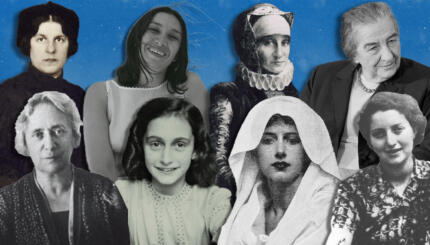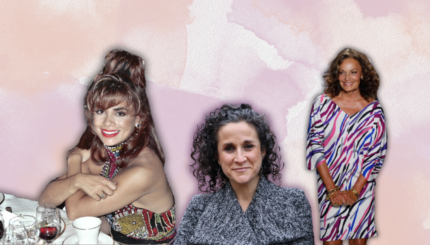Reprinted with permission from
JOFA
,The Jewish Orthodox Feminist Alliance.
Until the mid-1980s, modern Hebrew literature was dominated by men. There were some fine women novelists in Israel, but their works were generally considered minor. Veteran author, Amalia Kahana- Carmon, once said, “Just as Jewish women were exiled to the balcony of the synagogue, Israeli women novelists were relegated to the peripheries of Israeli literature.”
But in the last two decades, a revolution has been taking place, which has affected Orthodox women writers. Female writers have come into their own. In fact, they might even be perceived as dominating Israeli literature today. Their artistic outpouring is a consequence of socio psychological changes within the country.
Shifting Tides
From its beginnings in the 19th century, Hebrew literature struggled with collective issues, revolving around the fate of the Jewish people. Indeed, literature was a primary force in crystallizing the Zionist agenda. During the pioneering period and in the early days of the State of Israel, Hebrew literature projected a new image of the Jew as farmer and soldier.
Writers of the sixties, like Amos Oz and A.B. Yehoshua, attempted to retreat from the collective and focus on the individual. But they could not disengage themselves from national issues, and the individual was often used to symbolize the larger nation.
With your help, My Jewish Learning can provide endless opportunities for learning, connection and discovery.
During this time, women writers were perceived as sensitive observers of domestic psychological situations, not relevant to the debates in the public realm, and they remained on the sidelines. However, in the 1980’s a change took place in Israel. People began to thirst for works about the private realm. Young Israelis became weary of the constant involvement with nation-building.
They wanted to concentrate on personal interactions, rather than collective ones. Women’s literature, with its traditional emphasis on emotional relationships, was celebrated in this new milieu.
It emphasized female autonomy. Much of this striving for autonomy and self-knowledge is evident in the writing of observant or traditional-minded Israeli women novelists, such as Esther Ettinger, Hannah Bat-Shahar, Michal Govrin and Mira Magen.
In the works of each of these writers, the search for autonomy is played out against the background of an Orthodox family, community, or ideology. There are writers like Shira Horn and Yehudit Rotem who came out of haredi lifestyles, and write critically about this world, or use their backgrounds to create sensationalistic novels. But this is quite different from the approach of the writers under consideration in this essay, whose fiction grapples with the tensions between tradition and autonomy with depth and honesty.
Esther Ettinger
Peleh Laylah, (Night Wonder) a recent novel by the poet Esther Ettinger depicts the “coming of age” of a religious adolescent in Tel Aviv. There are many autobiographical elements in the work. Ettinger’s parents came from Eastern Europe before the war, and lost many relatives in the Holocaust. They were part of the Yiddish-speaking business community in Tel Aviv in the 1950s. The line between Orthodox and ultra-Orthodox was not clearly drawn at that time, and she was sent to a Bais Yakov school.
In her novel, Ettinger juxtaposes the Bais Yakov education of the protagonist Atara Henig with the girl’s attraction to the music, movies and fashion of Tel Aviv. Her teacher, Raizl, is a very pious survivor of Bergen-Belsen who espouses the teachings of the founder of Bais Yakov, Sara Schneirer, in an attempt to cleanse the young women of “foreign influences.”
Ettinger cleverly weaves passages from Sara Schneirer’s writings into the novel, and depicts the tension between home and school, on the one hand, and Tel Aviv, on the other. Ettinger contends that the conflict between art and religion in James Joyce’s Portrait of the Artist as a Young Man served as a model for her. It percolated many years, says Ettinger, who is married and has four married children. In spite of the tension between art and religion, Ettinger claims that the language of religious texts serve her well.
“The language is very much part of me, and becomes an organic part of my writing. It’s true that religious education inhibits the writer, but it also enriches her work. I feel freest when I write, but the writer must impose internal aesthetic limits on the work.” Realizing this, Ettinger also accepts the religious limits she imposes on her writing.
“Yet there are literary ways to accommodate these limits, through ‘drash, pshat, and remez,'” she explains.
Hannah Bat-Shahar
In contrast to Esther Ettinger, Hannah Bat-Shahar has, until recently, retained a strict division between her work and her personal life. The daughter of a well-known rabbi and wife of a rosh yeshiva, Bat-Shahar wrote under a pseudonym.
Only recently has she revealed her identity in the media. Her many short stories and novels are beautiful, densely written works, depicting the seething, internal world of a female protagonist. The language itself projects the sense of claustrophobia of a woman seeking to break out of a closed world. Certain patterns repeat themselves in Bat-Shahar’s work. The woman often has romantic longings for a man who is inappropriate for her. At the same time, the long shadow of a father-figure hovers over the protagonist throughout her life.
In the three novellas that make up Sham, Sirot Hadayig (Look, the Fishing Boats), Bat-Shahar moves from depictions of her tightly closed internal world to portray wider social interactions in religious circles. She depicts an upper class ultra-Orthodox world where the men are, by and large, businessmen constantly crossing lines between America, Europe and Israel.
In general, there is often real doubt about the credibility of Bat-Shahar’s female narrators. They are romantic to the point of being crazed in their judgments, frozen in a circumscribed world from which they yearn to flee. Bat-Shahar’s work, however, should not be perceived as a realistic depiction of the whole haredi world, but as a literary, psychological vision of a certain type of neurotic woman in this milieu.
Michal Govrin
Michal Govrin, the most conceptually oriented of the writers discussed, has also created a beautiful, densely written novel, Hashem, artfully translated from the Hebrew by Barbara Harshav as The Name (New York: Riverhead Books, 1998). Instead of portraying the inner world of a haredi girl, she has succeeded in getting into the head of a young ba’alat teshuva.
The very title Hashem bespeaks daring. It means The Name but it is also an almost intimate appellation for God, referring to a mystical-erotic relationship to God felt by the book’s protagonist, Amalia. In the highly secular Israeli literary scene, Govrin has written a novel in what might be called the liturgical mode, addressing God regularly.
She has structured her narrative around the counting of the omer, between Passover and Shavuot. In contrast to the predilection in recent Israeli literature for everyday street language and realism, The Name abounds with allusions to Jewish sources. Govrin’s work is written in the spirit of the earlier works of A.B Yehoshua and Amos Oz, in which the fiction is a symbolic structure driven by conceptual concerns.
The charismatic Govrin, a lecturer at the School for Visual Drama in Jerusalem, has published two volumes of poetry and short stories, as well as The Name. Her second novel, Hevzekim (Snapshots) which is now being translated into English, deals with an Israeli woman confronting her father’s Zionist ideals. Govrin’s father was from a kibbutz with strong Labor pioneering ideals.
Govrin has also called upon her own biography in writing “The Name.” Her mother was a Holocaust survivor. “I had childhood memories, the trauma of learning that my mother had a child before me that didn’t survive,” says Govrin.
“But growing up in Tel Aviv in the 1950s, there was no way of absorbing and digesting these experiences. Zionism and the State of Israel provided an official way to think about the Holocaust. But it didn’t leave any private space, either for personal pain or for memory. Everything was devoured by the machinery of nation-building.”
The heroine of the novel, Amalia, turns to religion as an alternative to this secular Israeli life. Govrin herself became interested in Judaism in Paris when she was working on her doctorate in theater. “But I never reached the realms of ecstatic experience which Amalia enters,” she declares.
According to the Kabbalah, evil is perceived as “a shattering of the cosmic vessels” and it is man’s goal to repair the brokenness of the universe through tikkun olam. Govrin depicts Amalia’s attempts at reparation after the Holocaust, helping God mend the break, by weaving a curtain for the Ark of the Torah during the 49 days of the omer between Passover and Shavuot. The omer symbolizes the ascent of the Jews from the state of bondage in Egypt to spiritual freedom, culminating with the revelation at Mount Sinai.
On the personal level, Amalia feels herself ascending to spiritual heights, ultimately, to become one with God. But she also perceives this fusion with the Almighty as an act of self-annihilation. Ultimately, Amalia backs away from the suicide option. “She claims more and more of the human dimension,” explains Govrin. “She accepts the fact that there are fissures in the universe. Instead of a mystic union with God, she becomes more tolerant of human limitations.
She serves as a catalyst to bring different types of people together,” explains the author. “Israelis are often afraid to cross borders.”
In this respect, Govrin herself is very much like Amalia; a bridge between different groups. Coming from a secular Zionist home, she is married to an observant French–Jewish mathematician, and has two daughters. She does not see herself as belonging to any defined group. “I prefer to move from one to the other. And I hope the book leaves that kind of open space to readers to do the same, to find their own answers.”
Mira Magen
Mira Magen also prefers not to be pigeonholed as religious or secular. Magen, who is shomeret Shabbat, prefers to straddle the fence, depicting the various options that Israelis from religious backgrounds might choose between. She grew up in an observant family in Kfar Saba, was for many years a nurse in Hadassah, and has written four novels. In an early novel, Al Takeh B’Kir (Do Not Strike the Wall) she traces the emergence of a young woman from a religious moshav to the big world. Her love for a young widower on the moshav leads her to delve into the exotic life of his dead wife. But it culminates in marrying the widower, who is himself grounded in tradition and a connection to the land.
In her later work, B’shachvi U B’kumi (Love, After All), Magen moves farther away from the religious framework. In this novel, Zohara Shiloh is a single mother, an unmarried nurse, who has left behind the religious kibbutz where she grew up. She is a “Jewish mother” in the sense that her concern for her son Evyatar dominates her life, until she falls in love with Mishael, a sophisticated high-tech businessman. In choosing Mishael, she opts for a more adventurous lifestyle.
In Magen’s family chronicle, Malachim Nirdamu Kulam (Her Angels Have All Fallen Asleep), five siblings wrestle with their religious upbringing, each taking a different direction in his or her life.
For the authors discussed in this essay, the options of Robert Frost’s The Road Not Taken, are ever present in their writing, as they are in the life of many Orthodox men and women. Some might see this as undermining the veracity of religious life decisions. Yet, it is exactly this existential doubt with which the contemporary religious woman struggles daily, realizing the contingency of all life choices. It is this that gives these works the tension and depth that are often absent from the works of many secular Israeli women novelists, who generally depict an everyday life with less metaphysical struggle.
haredi
Pronounced: hah-RAY-dee, Origin: Hebrew, literally "in awe of" or "fearing" God, this means ultra-Orthodox or fervently Orthodox.
kibbutz
Pronounced: ki (short i)-BOOTZ (oo as in book), Origin: Hebrew, a collectively owned and run community in Israel.
Torah
Pronunced: TORE-uh, Origin: Hebrew, the Five Books of Moses.


